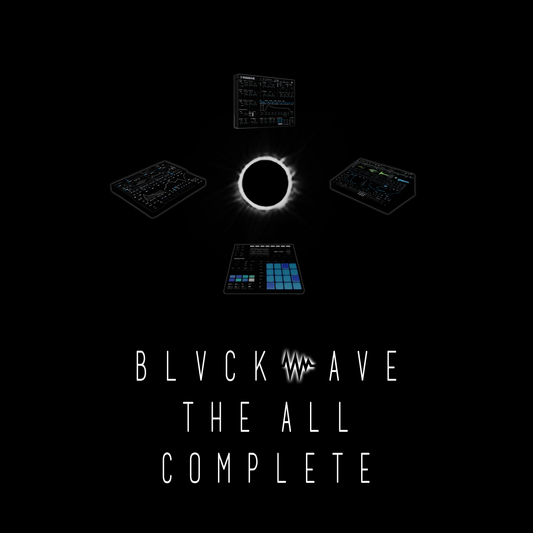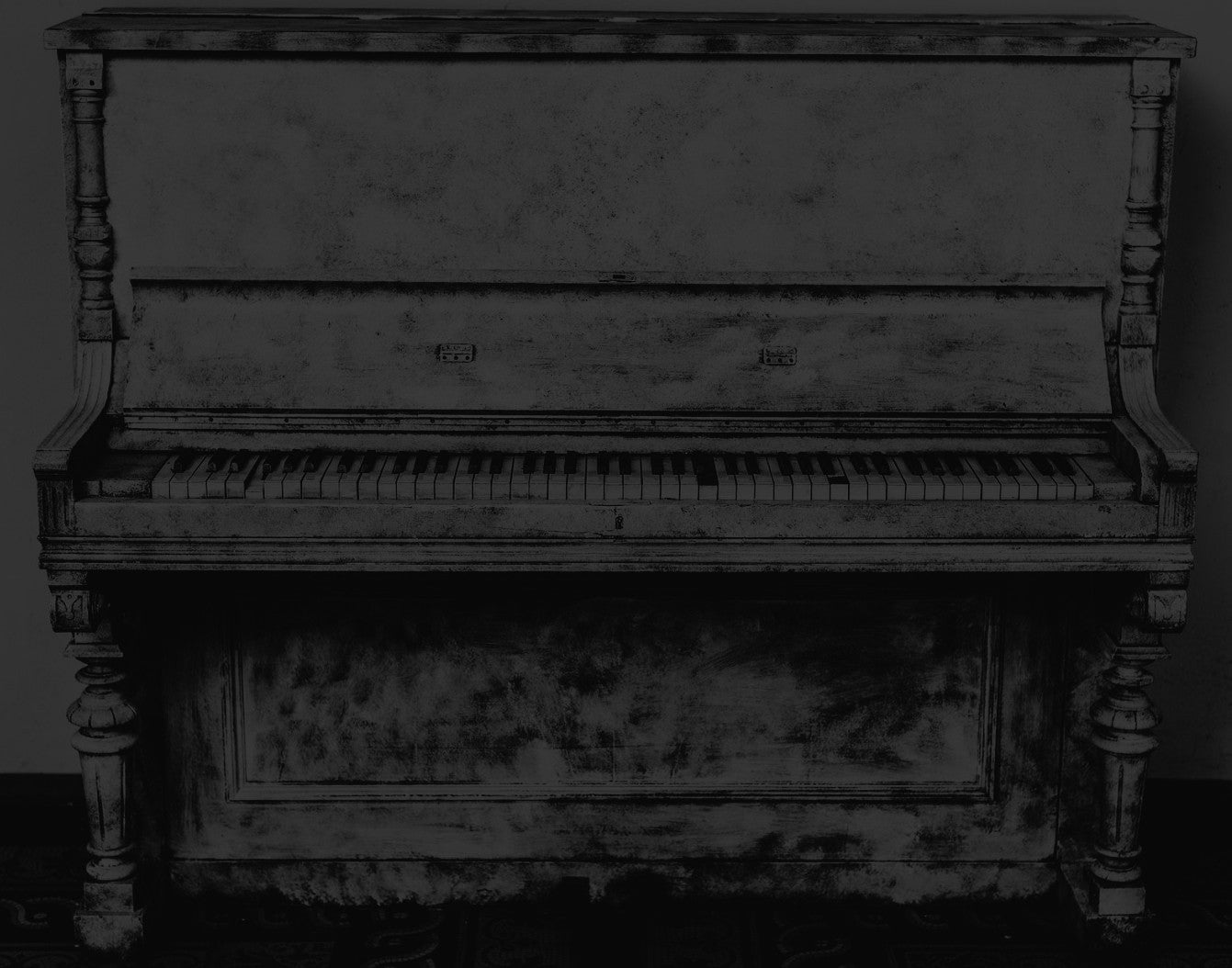
THE MOST RACIST PIANO TRICK!!!
THE MOST RACIST PIANO TRICK... BUT NOT REALLY
Yeah this is a clickbait title, but it doesn’t take away from how racist it is to only use the white keys on your keyboard. Which is not racist at all. In our case, we have a one of those cool limited edition MIDI controller with all BLACK keys so we're definitely not racist. At this point, I am sure you are either not even reading this or asking yourself “HOW DOES THIS "RACIST" PIANO TRICK HELP ME LEARN ALL THE KEYS?”
Let's begin by taking a look at the KEY of C MAJOR / A MINOR (which is just all the white keys on the piano; super racist I know) If we can become proficient with a few key chord shapes and scale patterns in THE KEY OF C MAJOR / A MINOR; we will have a very strong music theory foundation to build future knowledge on. Luckily, these beginner shapes are VERY EASY to memorize.
With this small batch of music theory knowledge, we can use modern technology to effectively “HACK” our way through all of the other KEY SIGNATURES by using the TRANSPOSE (changing the “tuning/key” of) feature on your midi controller or DAW. You can also use this trick to learn common (sometimes seemingly complex and advanced) “BROKEN MUSIC THEORY RULES” and put them into context within this key of C/Am so those “magical chords” and “modulations” seem less esoteric and more reachable.
In addition to being an amazing learning tool and workflow speed booster, This simple but powerful key of C / A MINOR transposing trick makes production work where you have to perform difficult musical lines very easy, even if you have limited piano skills. If you already have a decent understanding of music theory, you might quickly discover you could be “the next Mozart” after seeing how easy it is to compose and improvise with this new understanding of music as a whole. But maybe only in the key of C (with some cool broken rules for flavor)… for now. LMAO. (or “CHEAT” your way into other keys using TRANSPOSE)

WHITE KEY TRIADS (THE KEY OF C/Am)
For this series of chords we will play TRIADS. These triads are just 3 finger, 3 note versions of the chords. For the root position of the chord I like to use the easy concept of “PLAY ONE, SKIP ONE, PLAY ONE, SKIP ONE, PLAY ONE”.
There is no right or wrong way to play the shape at this stage. I prefer to use the pinky, index, and thumb fingers to play the chord. This allows us to change to a 7th chord easily in the future once you learn the basic triads.

THE ROOT TRIAD CHORDS IN "C / A MINOR"
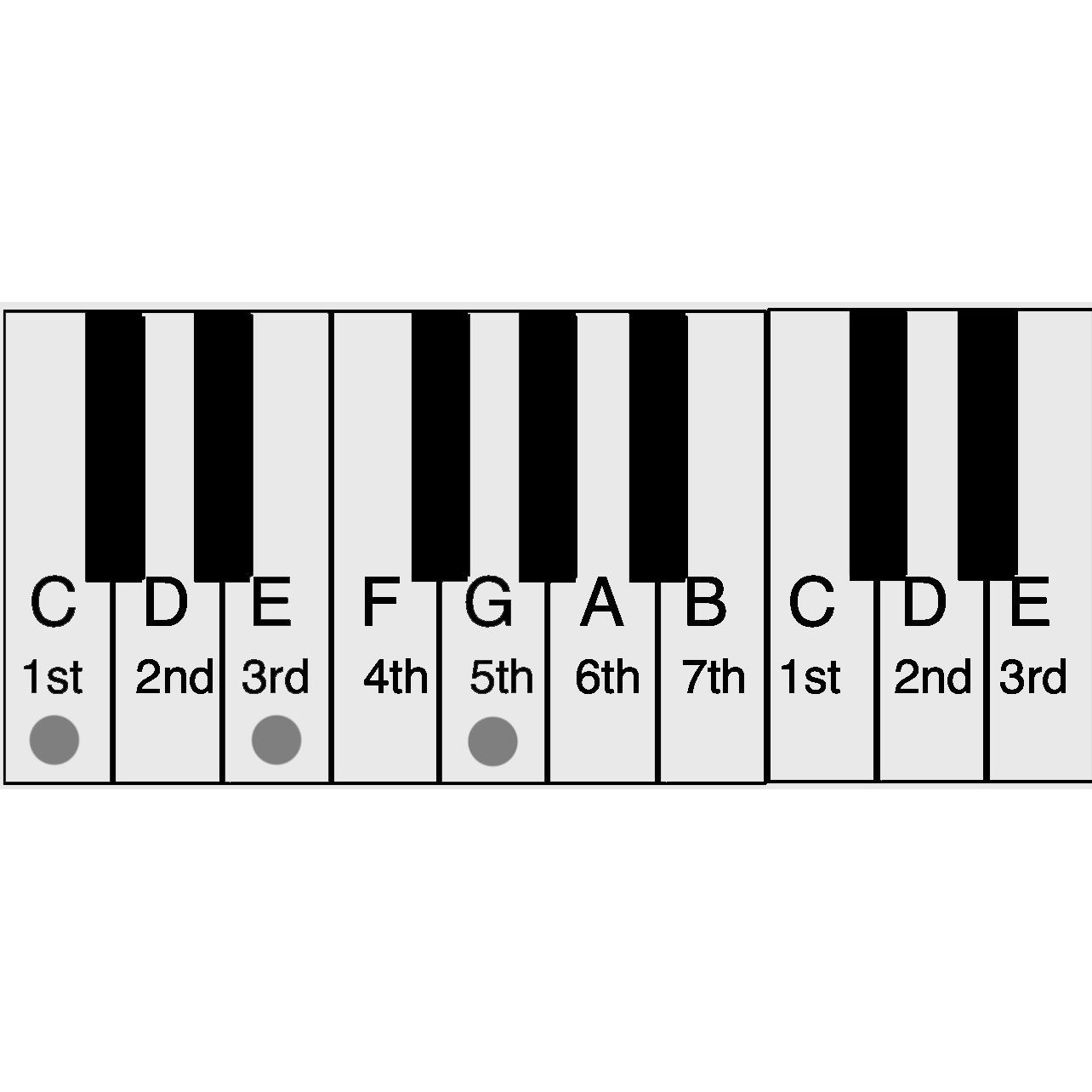
THE "1" - C MAJOR = C = I = 1 = TONIC (MAJOR ROOT)
For this first position start at C and simply PLAY ONE, SKIP ONE, PLAY ONE, SKIP ONE, PLAY ONE. This will result in the notes C, E, and G; which is the 1st 3rd and 5th note of the scale. This is our 1st chord in a series of chords that all fit into a "chord family". Commonly called the "1 chord" or the "Tonic" in the Key of C.
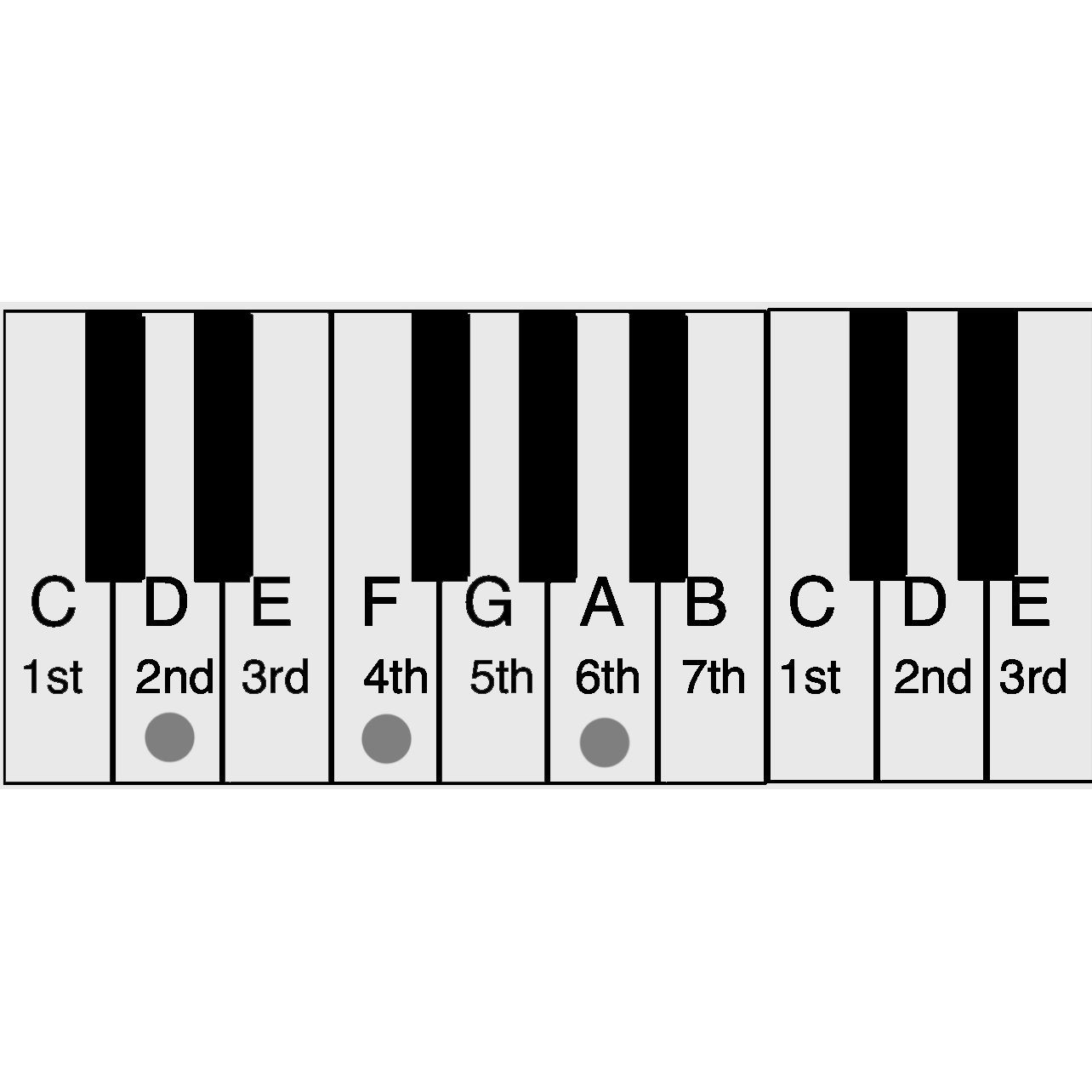
THE "2" - D MINOR = Dm = 2 = ii = SUPERTONIC
For our second chord position start at D, and simply "PLAY ONE, SKIP ONE, PLAY ONE, SKIP ONE, PLAY ONE". This will result in the notes D, F, and A. This is our 2nd chord in a series of chords that all fit into a "chord family". Commonly called the "2 chord" or the "SUPERTONIC" in the Key of C.

THE "3" - E MINOR = Em = iii = 3 = MEDIANT
For our third chord position, start at E and simply "PLAY ONE, SKIP ONE, PLAY ONE, SKIP ONE, PLAY ONE". This will result in the notes E, G, and B. This is our 3rd chord in a series of chords that all fit into a "chord family". Commonly called the "3 chord" or the "MEDIANT" in the Key of C.
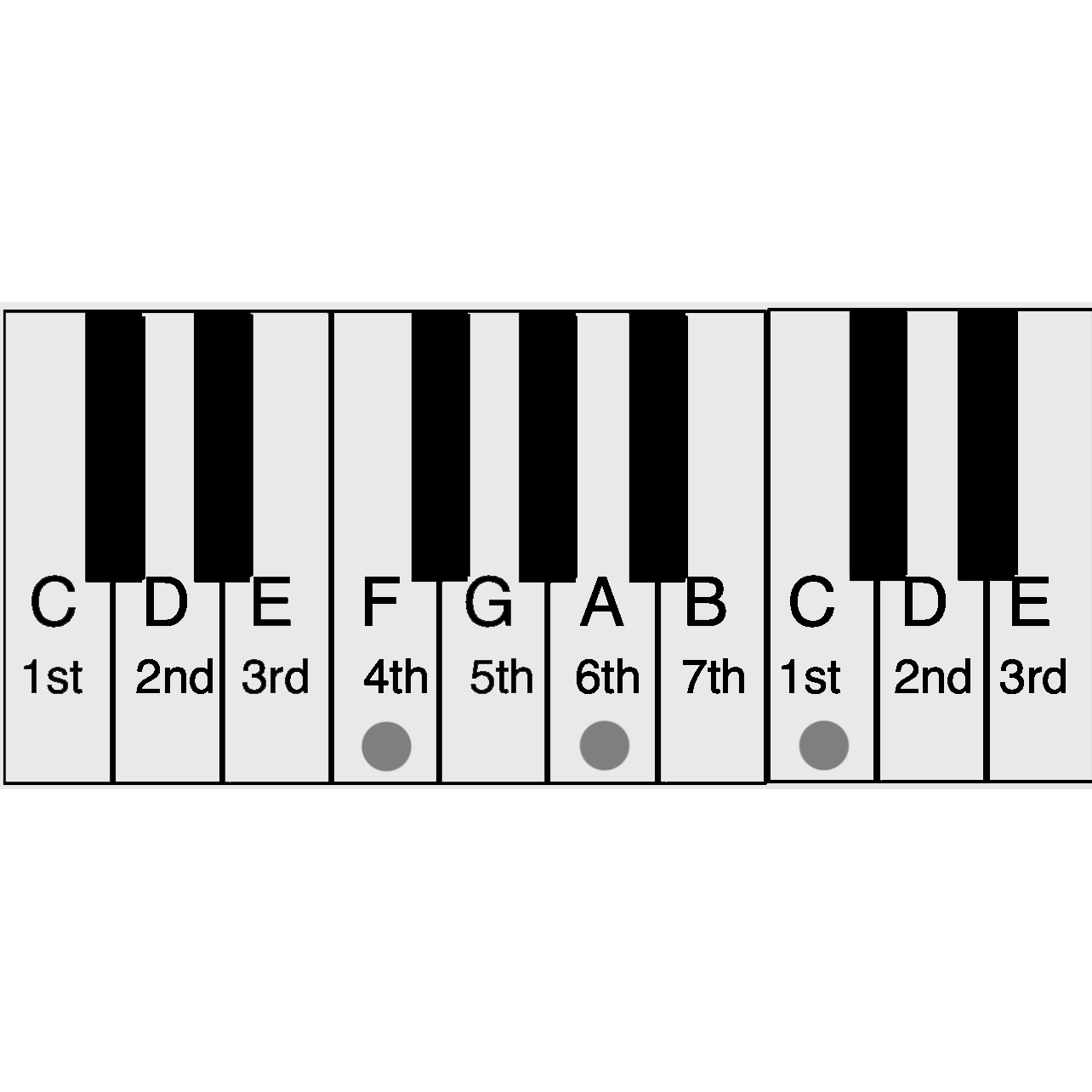
THE "4" - F MAJOR = F = IV = 4 = SUBDOMINANT
For our fourth chord position, start at F and simply "PLAY ONE, SKIP ONE, PLAY ONE, SKIP ONE, PLAY ONE". This will result in the notes F, A, and C. This is our 4th chord in a series of chords that all fit into a "chord family". Commonly called the "4 chord" or the "SUBDOMINANT" in the Key of C.

THE "5" - G MAJOR = G = V = 5 = DOMINANT
For our fifth chord position, start at G and simply "PLAY ONE, SKIP ONE, PLAY ONE, SKIP ONE, PLAY ONE". This will result in the notes G, B, and D. This is our 5th chord in a series of chords that all fit into a "chord family". Commonly called the "5 chord" or the "DOMINANT" in the Key of C.
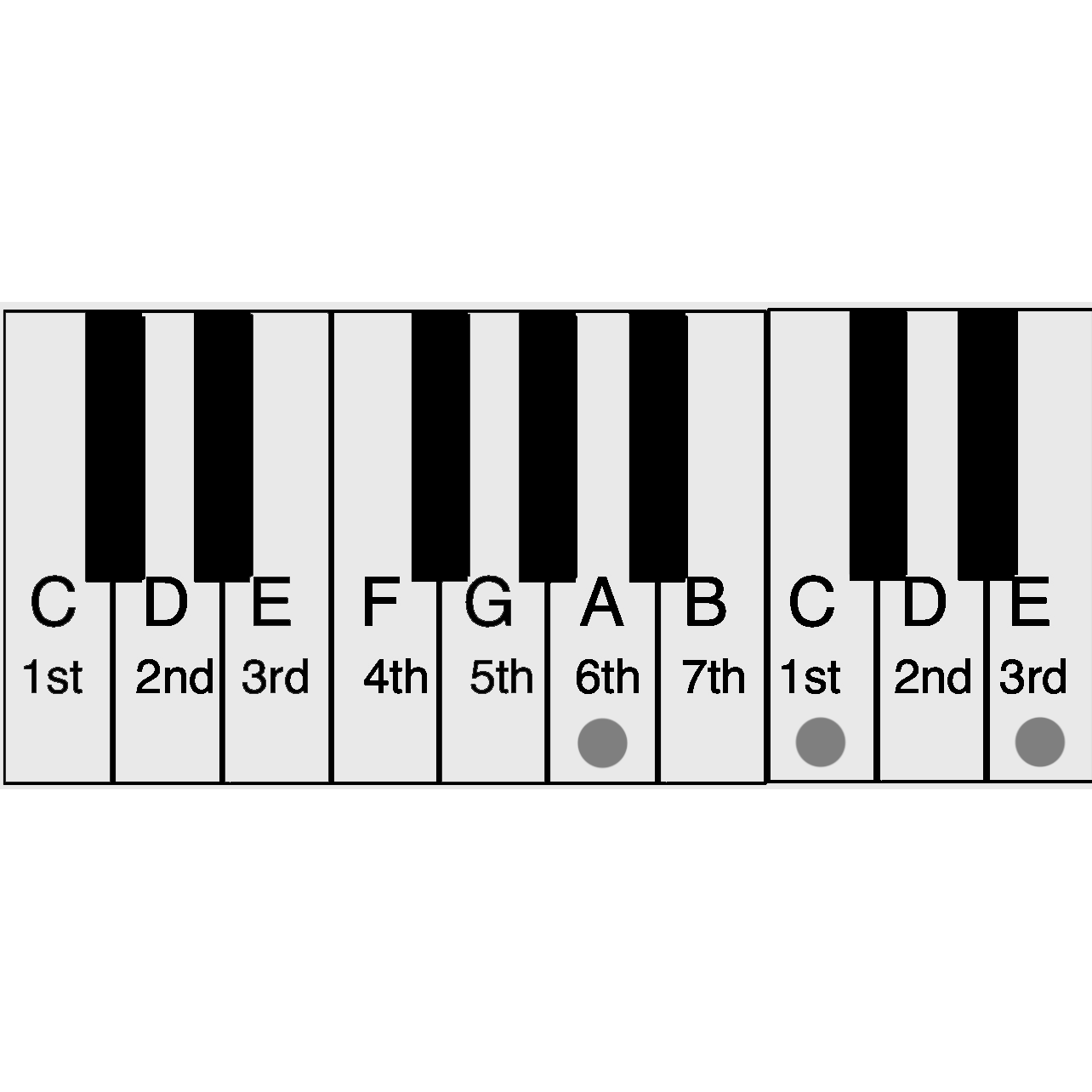
THE "6" - A MINOR = Am = vi = 6 = SUBMEDIANT (MINOR ROOT)
For our sixth chord position, start at F and simply "PLAY ONE, SKIP ONE, PLAY ONE, SKIP ONE, PLAY ONE". This will result in the notes A, C, and E. This is our 4th chord in a series of chords that all fit into a "chord family". Commonly called the "6 chord" or the "SUBMEDIANT" in the Key of C.
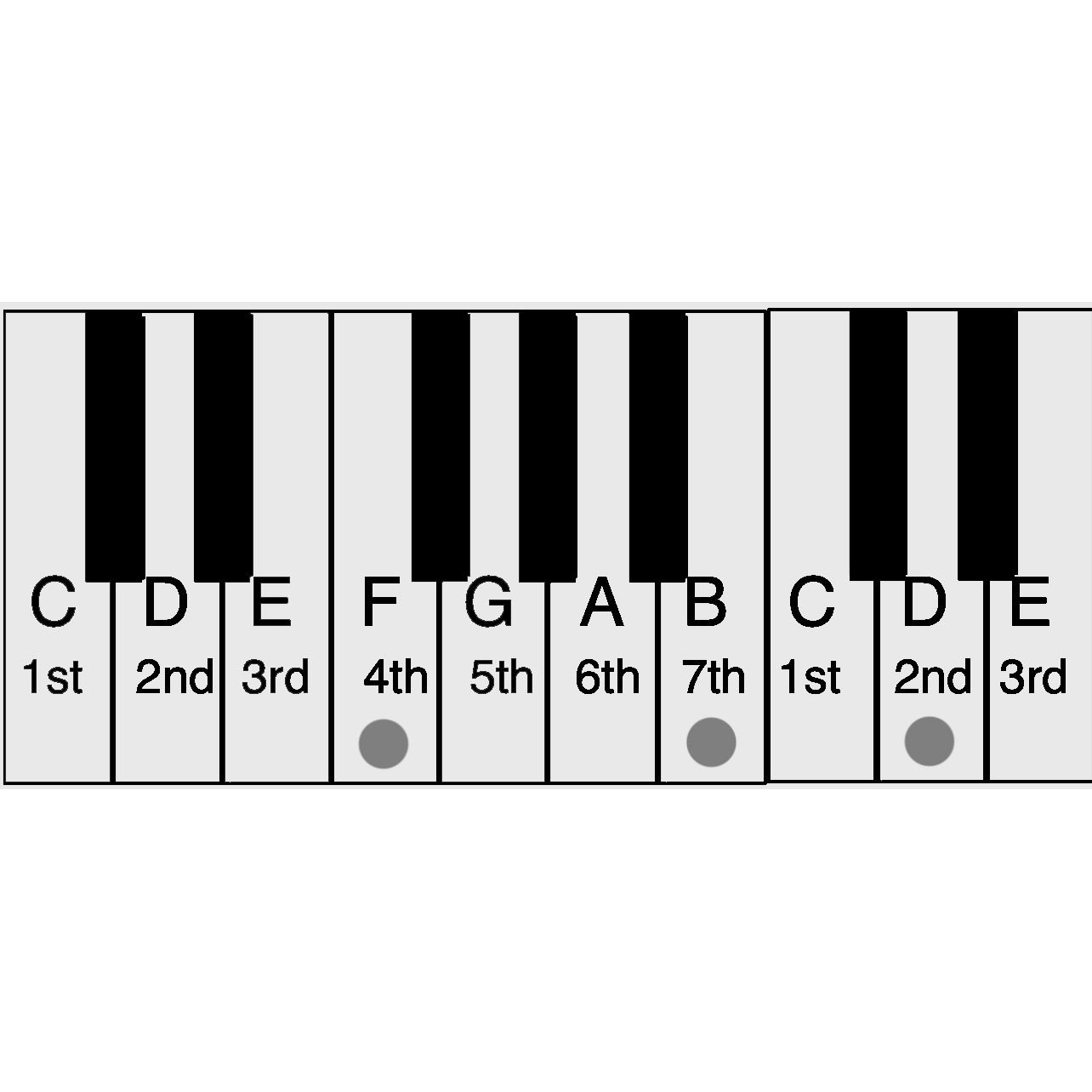
THE "7" - B DIMINISHED = B°dim = vii° = 4 = SUBTONIC / LEADING TONE
For our seventh chord position, start at B and simply "PLAY ONE, SKIP ONE, PLAY ONE, SKIP ONE, PLAY ONE". This will result in the notes B, D, and F. This is our 7th chord in a series of chords that all fit into a "chord family". This is a special chord in the sequence as it is the last chord before it brings us back to the "1 chord", C major. No other chord in the key has this diminished tonality. Commonly called the "7 chord" or the "SUBTONIC / LEADING TONE" in the Key of C. (In the example photo you cannot see the high F, so it was added an octave lower for visualization purposes.)

SCALES & MODES IN "C / A MINOR"
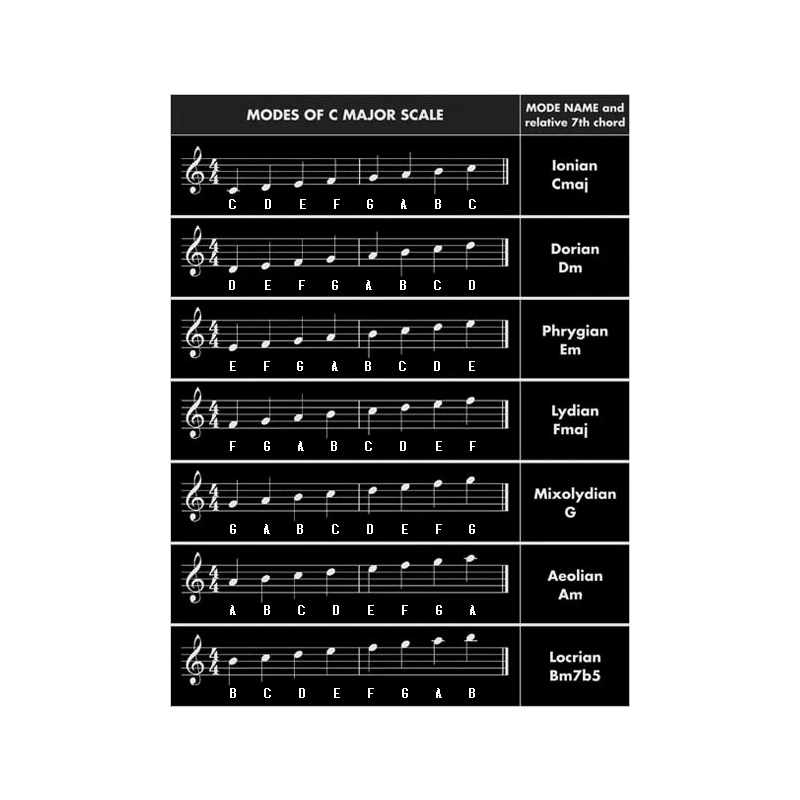
WHITE KEY MODES (THE KEY OF C/Am)
In addition to these simple TRIADS we also have an associated scale or “MODE” that compliments each chord and/or note of the scale.
Of course there are “no rules” when it comes to music. But trying to forcibly use these "modalities" in the "wrong" ways can lead to frustration.
For now, AT LEAST IN THE START, try to focus on the NATURAL MAJOR (C Ionian) and the NATURAL MINOR (A Aeolian) as most modern pop music stems from those “natural” scales and they are the most familiar and easiest to train your ear to hear.
In the beginning stages, feel free to jam and improvise around on ALL the white keys. Just use "A" as your tonal center if you want to sound "MINOR" and "C" as a tonal center if you want to sound "MAJOR".
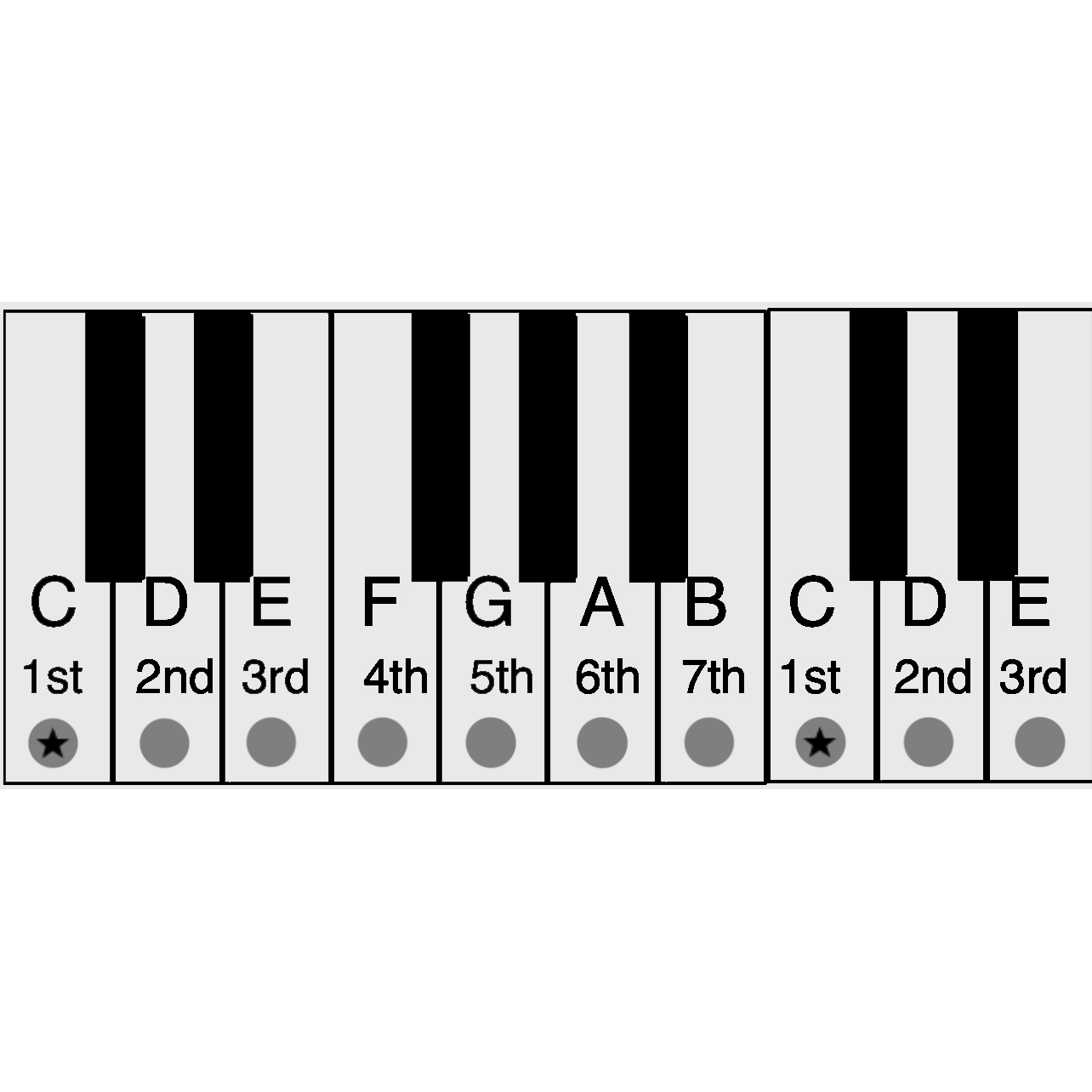
C IONIAN MODE (NATURAL MAJOR SCALE)
The IONIAN MODE is the first mode of the diatonic scale and is also commonly referred to as the NATURAL MAJOR SCALE. Simply play from C to C on the white keys of your keyboard and repeat infinitely in either direction with C being the focal point of the scales sound. Often called the "ROOT" or "HOME' note. The majority of POPULAR MUSIC is written in NATURAL MAJOR (Ionian) or NATURAL MINOR SCALE (Aeolian) modes.
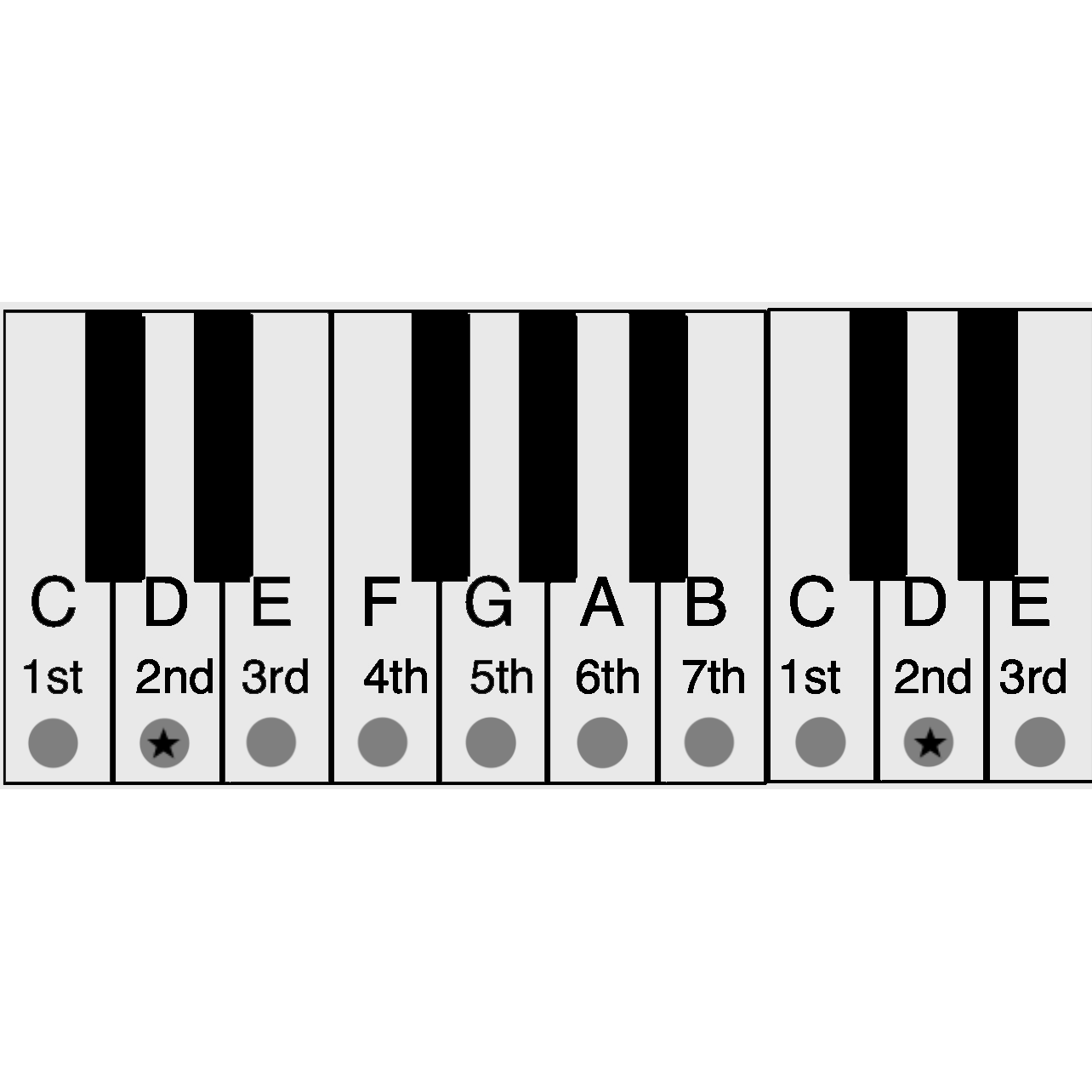
D DORIAN MODE
The DORIAN MODE is the second mode of the diatonic scale. Simply play from D to D on the white keys of your keyboard and repeat infinitely in either direction with D being the focal point of the scales sound. Often called the "ROOT" or "HOME' note.
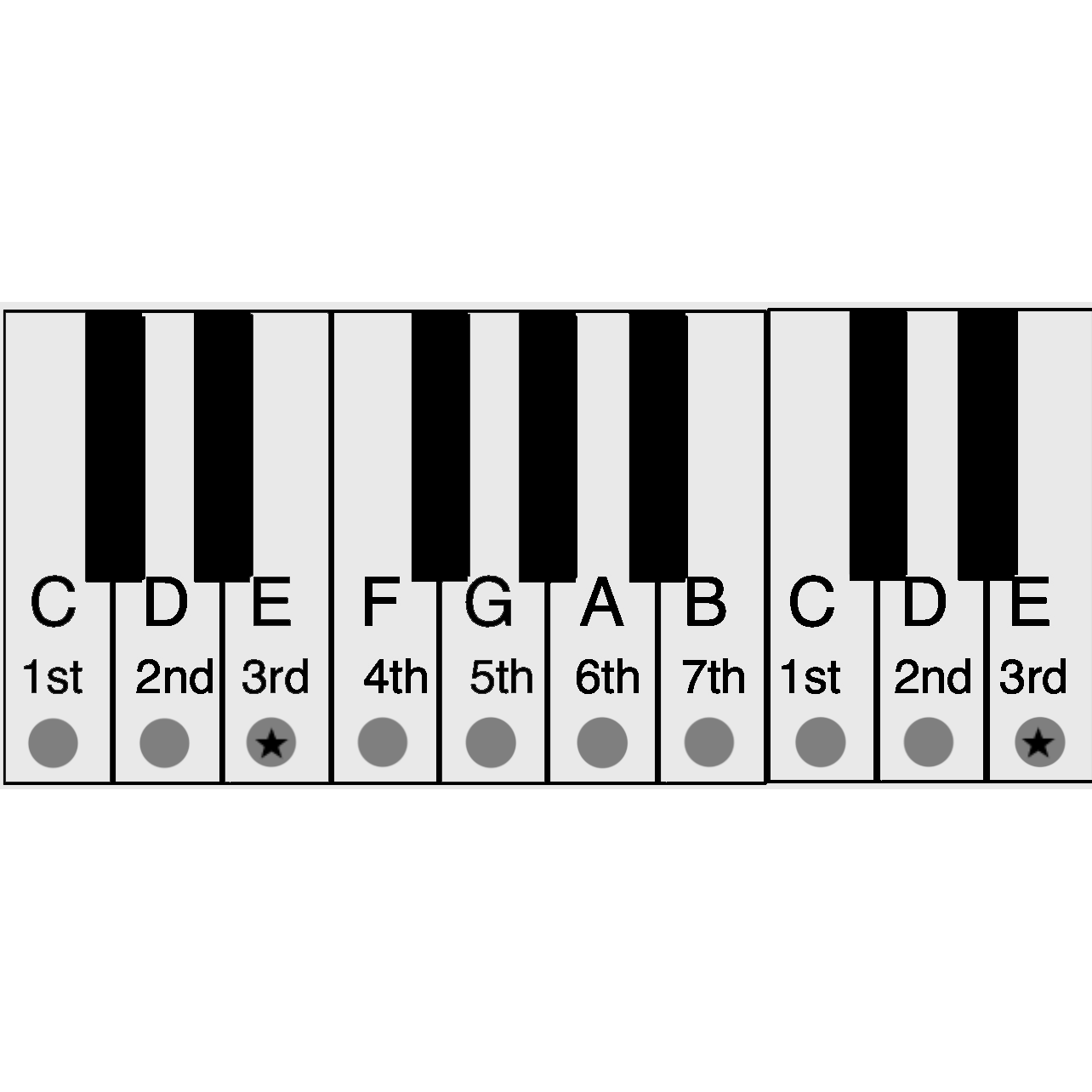
E PHRYGIAN MODE
The PHRYGIAN MODE is the third mode of the diatonic scale. Simply play from E to E on the white keys of your keyboard and repeat infinitely in either direction with E being the focal point of the scales sound. Often called the "ROOT" or "HOME' note.
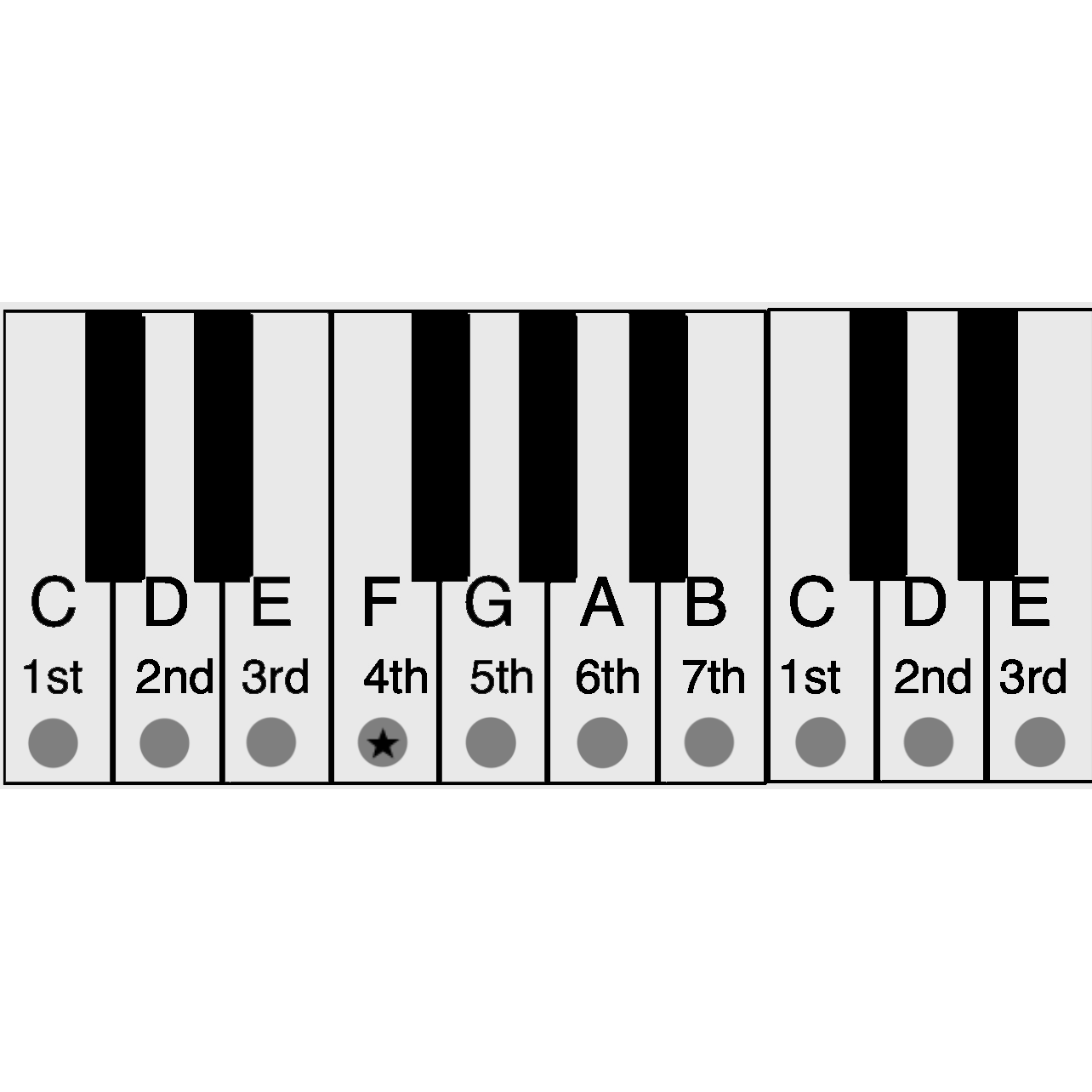
F LYDIAN MODE
The LYDIAN MODE is the fourth mode of the diatonic scale. Simply play from F to F on the white keys of your keyboard and repeat infinitely in either direction with F being the focal point of the scales sound. Often called the "ROOT" or "HOME' note.
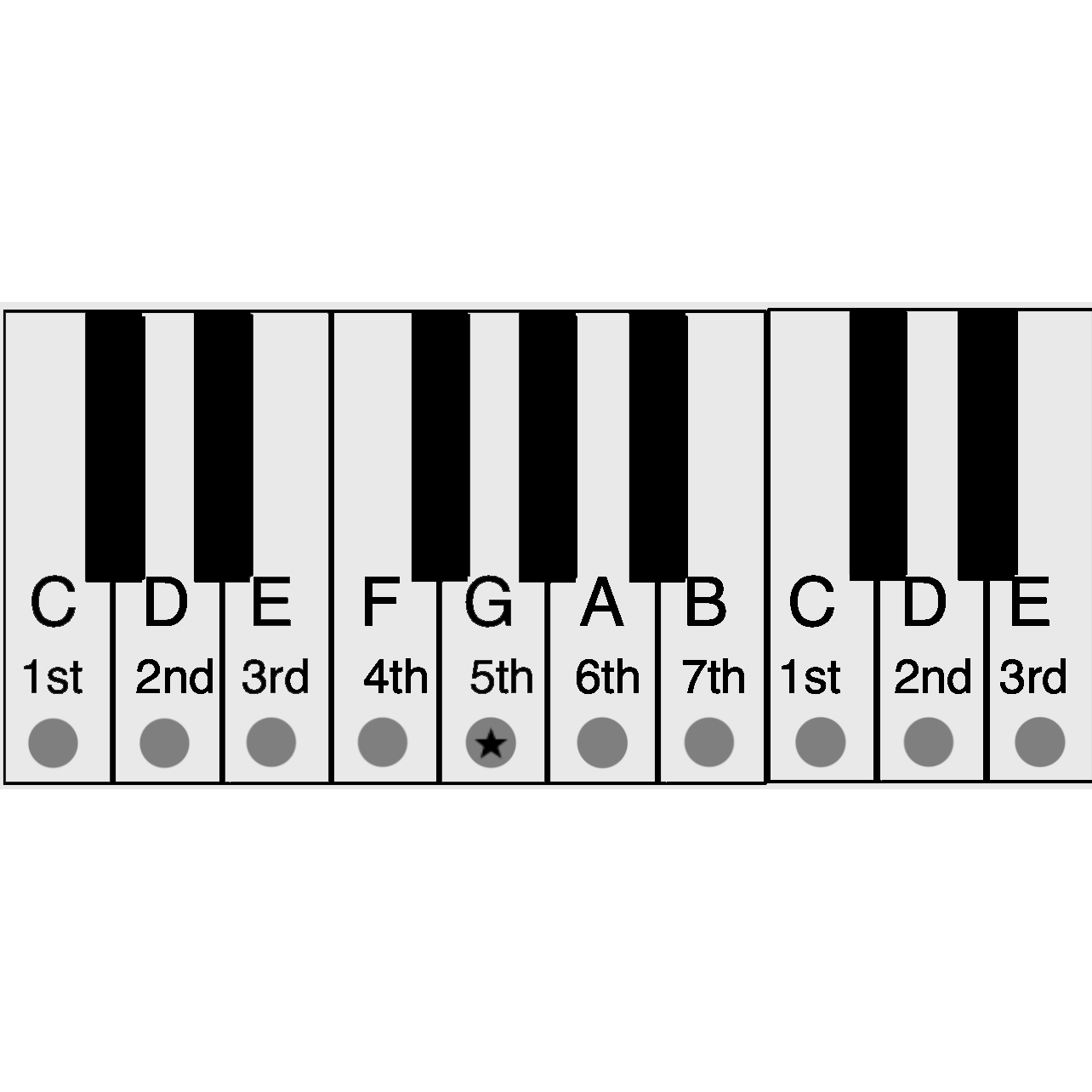
G MIXOLYDIAN MODE
The MIXOLYDIAN MODE is the fifth mode of the diatonic scale. Simply play from G to G on the white keys of your keyboard and repeat infinitely in either direction with G being the focal point of the scales sound. Often called the "ROOT" or "HOME' note.
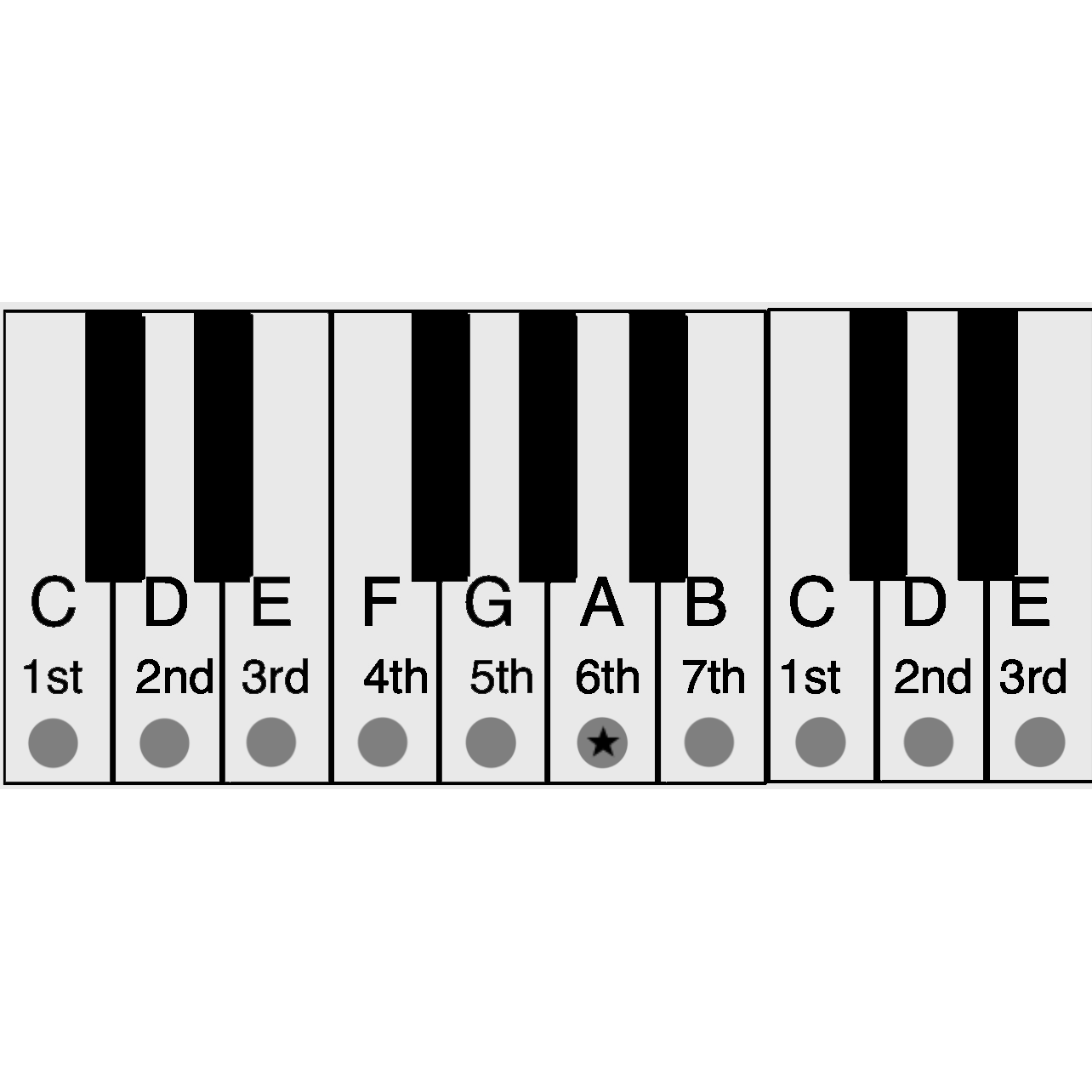
A AEOLIAN MODE
The AEOLIAN MODE (NATURAL MINOR SCALE) is the sixth mode of the diatonic scale. Simply play from A to A on the white keys of your keyboard and repeat infinitely in either direction with A being the focal point of the scales sound. Often called the "ROOT" or "HOME' note.
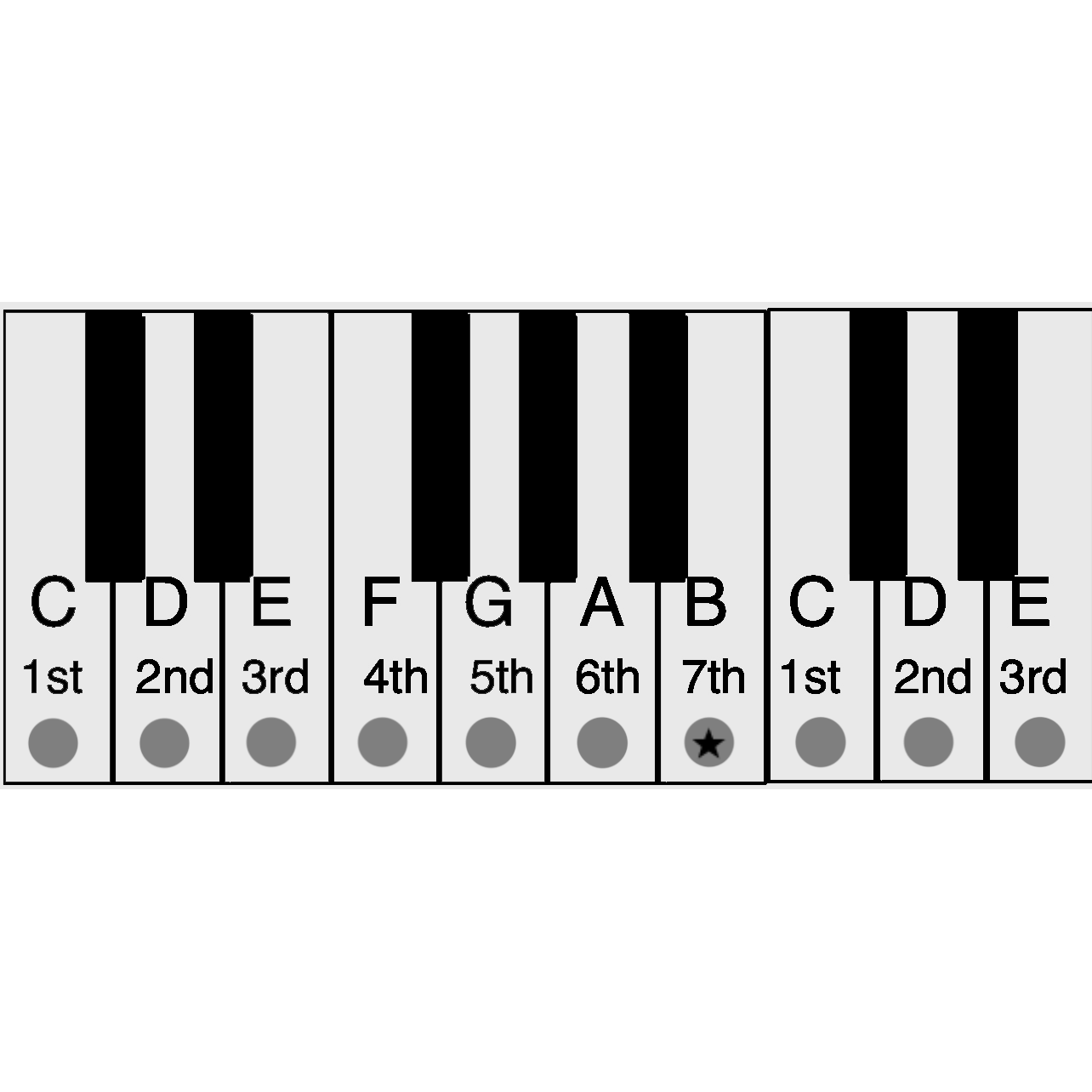
B LOCRIAN MODE
The LOCRIAN MODE is the seventh mode of the diatonic scale. Simply play from B to B on the white keys of your keyboard and repeat infinitely in either direction with B being the focal point of the scales sound. Often called the "ROOT" or "HOME' note.

ADDITIONAL SCALES & MODES IN "C / Am"
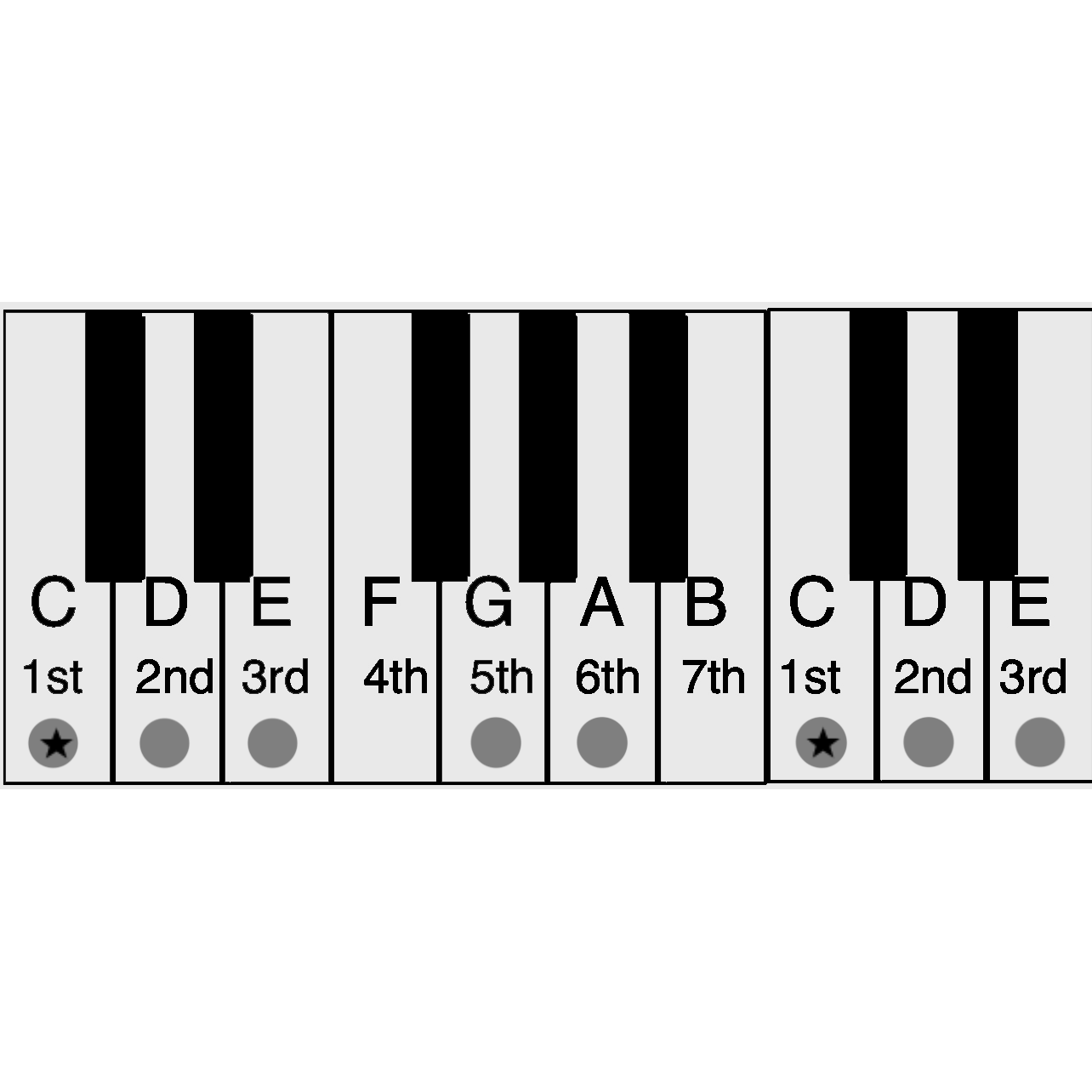
C MAJOR / A MINOR PENTATONIC SCALE
To play the pentatonic scale in C / A Minor simply SKIP the B and F.
To play in MAJOR PENTATONIC start on "C" and use "C" as the "tonal center" of the scale. (C, D, E , G, A)
To play in MINOR PENTATONIC start on "A" and use "A" as the "tonal center" of the scale. (A, C, D, E, G,)
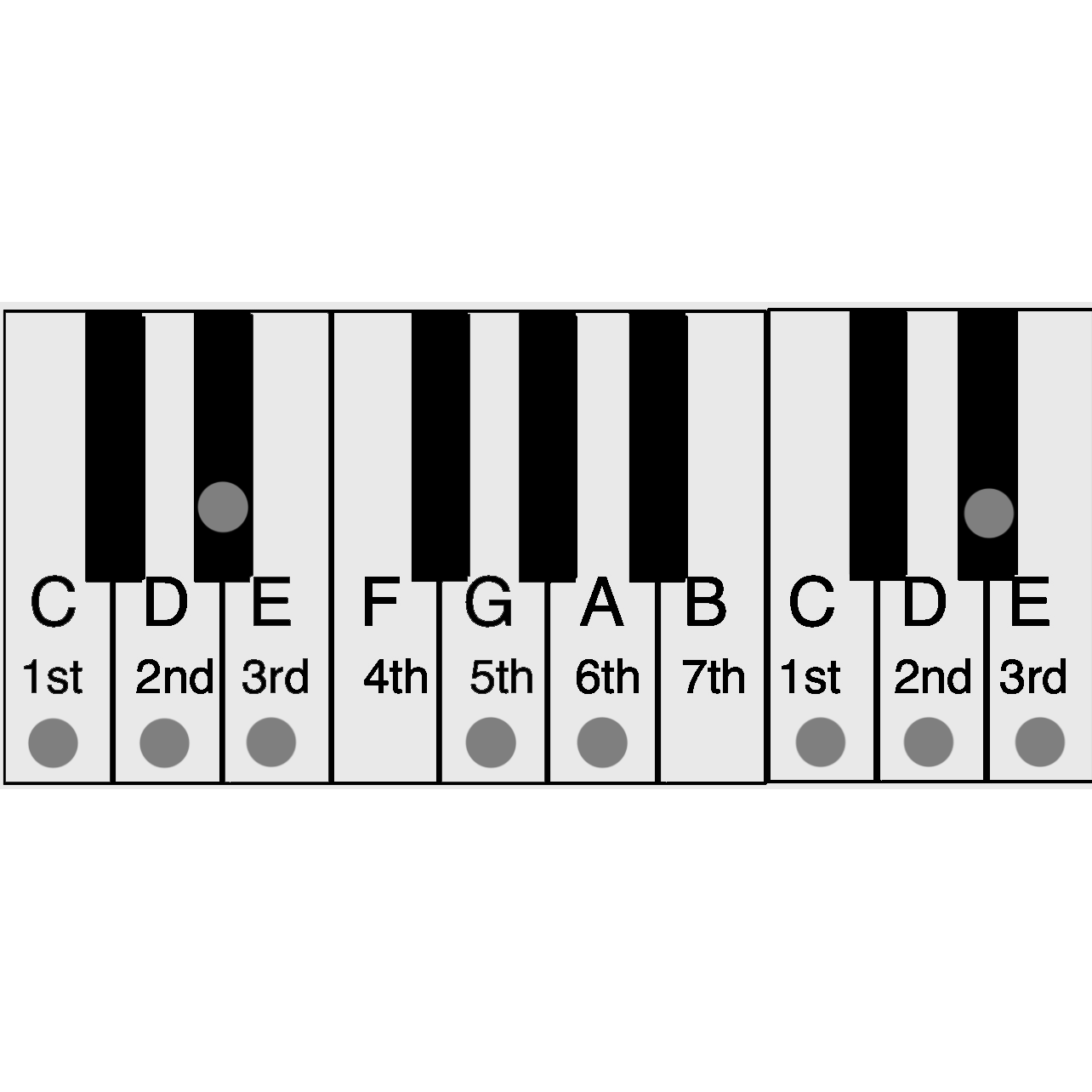
C MAJOR / A MINOR PENTATONIC "BLUES" SCALE
To add some “SOUL” to your playing try adding “THE BLUES NOTE” and add the D# to the scale to form a PENTATONIC BLUES SCALE.
To play in MAJOR PENTATONIC start on "C" and use "C" as your "tonal center" and only use the D# as a "passing tone". Avoid resting on this D#. (C, D, D#, E , G, A,)
To play in MINOR PENTATONIC start on "A" and use "A" as your "tonal center" and only use the D# as a "passing tone". Avoid resting on the D#. (A, C, D, D#, E, G,)

HARMONIC MINOR (AND ITS CHORDS / MODES)
To add a little bit of “broken rule” flavor to your boring diatonic triads try SUBSTITUTING a "G#" IN PLACE OF the "G" within your C/Am scale.
The new scale that forms if we begin using our "A" as the ROOT is called the "A" HARMONIC MINOR SCALE. (A, B, C, D, E, F, G#)
This sound also has it’s own set of unique modes that we won’t cover in this article but you can easily dissect by using the theory from the previous paragraphs.
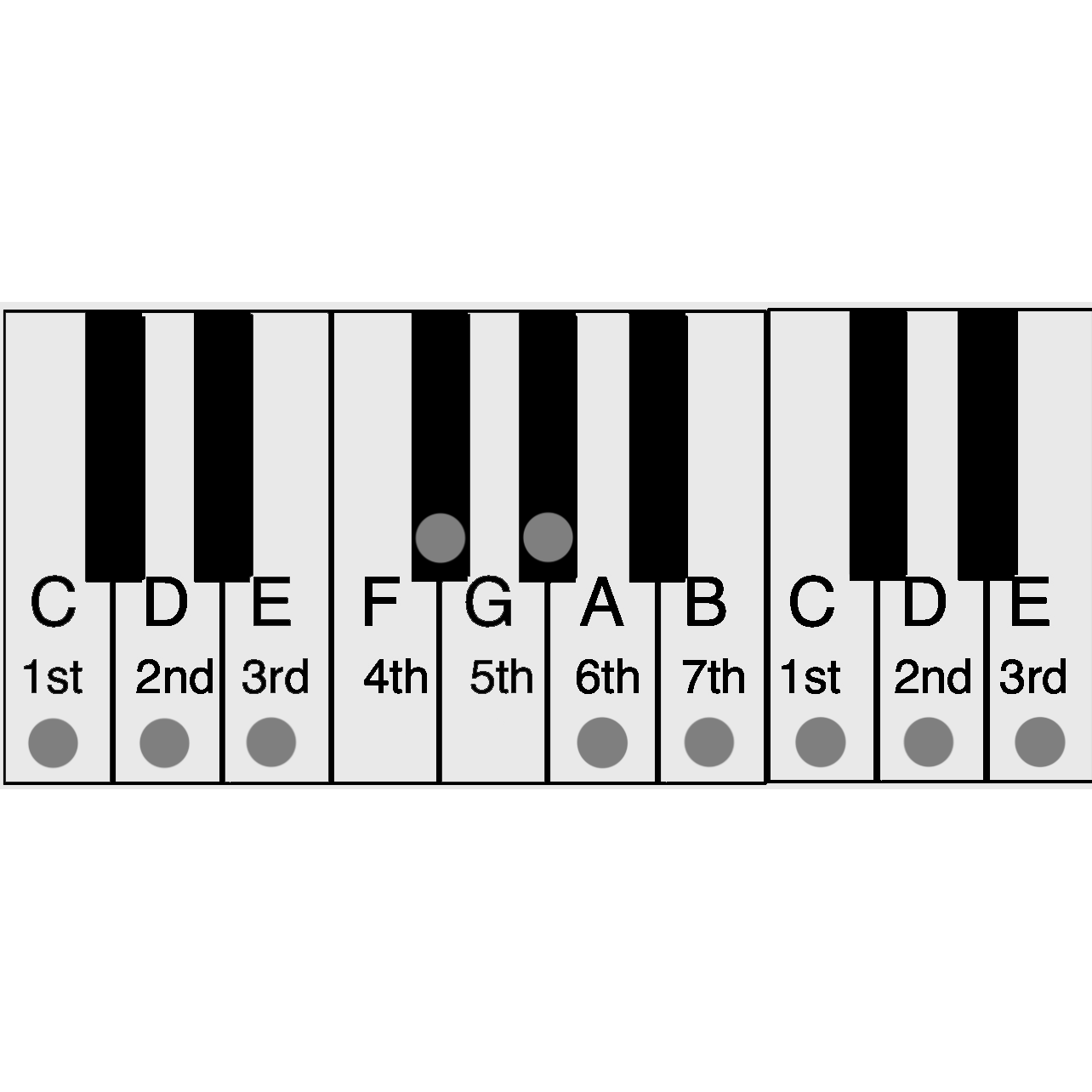
MELODIC MINOR (AND ITS CHORDS / MODES)
For even more “broken rule” flavor try substituting an "F#" AND a "G#" in place of your regular "F" and "G" within your C/Am diatonic scale.
The new scale that forms if we begin using our "A" as the ROOT is called the "A" MELODIC MINOR SCALE.
A, B, C, D, E, F#, G#
This sound also has it’s own set of unique chords and modes that we won’t cover in this article but you can easily dissect by using the theory from the previous paragraphs.
THE FINAL ULTIMATE WHITE KEY HACK!!! TRANSPOSING
Now that we have this vast amount of musical knowledge all contained within the KEY OF C / A MINOR let's use the TRANSPOSE feature on your MIDI CONTROLLER to "HACK" our way though every key with ease.
Obviously not every song is in the KEY OF C/Am. However, we CAN use the TRANSPOSE feature on our MIDI CONTROLLER to use this knowledge in ANY KEY. By using TRANSPOSE we can now compose in any key using only the white keys! (With some occasional accidentals if we use the Harmonic Minor or Melodic Minor or "Blues" scale systems we mentioned above.)
Visually on most MIDI controllers the TRANSPOSE FEATURE will use the symbols "+1, +2, +3 or -1, -2, -3" to determine how many KEYS higher you are or lower you are TRANSPOSED away from C/Am
You can use this simple chart below to figure out how to make ALL THE WHITE KEYS in tune with the key you want to work in. (Don’t try to lecture me about Bb this or Ab that, I don’t care. If you already know about that, what are you even doing here reading this?)
- C/Am +0
- C#/A#m +1
- D/Bm +2
- D#/Cm +3
- E/C#m +4
- F/Dm +5
- F#/D#m +6
- G/Em +7
- G#/Fm +8
- A/F#m +9
- A#/Gm +10
- B/G#m +11
To TRANSPOSE using this information, refer to your user manual or guide that came with your keyboard. Usually there is a button that says TRANSPOSE or OCTAVE. If you can find and OCATVE button but not a TRANSPOSE button you can likely hold the "SHIFT" button (As on the NI KOMPLETE KONTROL) or go into the MIDI CONTROLLER’s settings menu and search for TRANSPOSE there.
If not, then figure it out… Come on. It’s not that hard. You probably aren’t even reading this at this point anyway. Go on now. Get out of here and go make something dope.

POPULAR BLVCKWAVE PRODUCTS
To see our full selection view the BLVCKWAVE STORE HERE and get our FREE SAMPLE PACK sent to your email!
-
BLVCKWAVE CORE - COMPLETE
Regular price $999.99 USDRegular priceUnit price / per -
BLVCKWAVE MASSIVE - COMPLETE
Regular price $149.99 USDRegular priceUnit price / per -
BLVCKWAVE SERUM 1 & 2 - COMPLETE
Regular price $199.99 USDRegular priceUnit price / per -
BLVCKWAVE - THE ALL COMPLETE
Regular price $1,333.33 USDRegular priceUnit price / per



